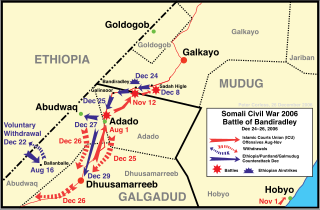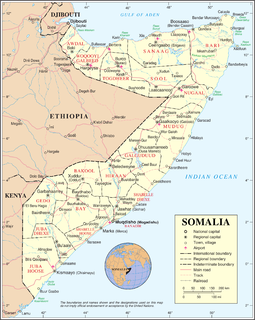
The Somali Civil War is an ongoing civil war taking place in Somalia. It grew out of resistance to the military junta led by Siad Barre during the 1980s. By 1988–90, the Somali Armed Forces began engaging various armed rebel groups, including the Somali Salvation Democratic Front in the northeast, the Somali National Movement in the northwest, and the United Somali Congress in the south. The clan-based armed opposition groups eventually managed to overthrow the Barre government in 1991.

The Second Battle of Mogadishu was a battle fought for control of Somalia's capital city, Mogadishu. The opposing forces were the Alliance for the Restoration of Peace and Counter-Terrorism (ARPCT), and militia loyal to the Islamic Courts Union (ICU). The conflict began in mid-February 2006, when Somali warlords formed the ARPCT to challenge the ICU's emerging influence. The ICU's influence was largely generated by wealthy financial donors who sought to enable the Islamic Courts Union to seize power in the country to bring stability. The battle is referred to as the Second Battle to distinguish it amongst the nine major Battles of Mogadishu during the decades-long Somali Civil War.

The Islamic Courts Union was a group of Sharia courts that united themselves to form a rival administration to the Transitional Federal Government (TFG) of Somalia, with Sharif Sheikh Ahmed as their head. They were also known as the Joint Islamic Courts, Union of Islamic Courts (UIC), Supreme Islamic Courts Council (SICC) or the Supreme Council of Islamic Courts (SCIC).
Hassan Dahir Aweys is a Somali political figure who was added to the U.S. government's list of terrorists in 2001. Aweys was the head of the 90-member shura council of the Islamic Courts Union (ICU) of Somalia and was viewed as one of the more radical leaders of the Union, which promoted shari'a and directed the militias that took control of the Somali capital of Mogadishu in June 2006. An eight-member executive committee was headed by the more moderate Sharif Sheikh Ahmed. The BBC stated "It is still not clear which man is more powerful." Aweys resigned from the ICU on 28 December 2006, at the end of ICU rule in Mogadishu.

The Somali Civil War was an armed conflict involving largely Ethiopian and Somali Transitional Federal Government (TFG) forces and Somali troops from Puntland versus the Somali Islamist umbrella group, the Islamic Court Union (ICU), and other affiliated militias for control of the country. There is a clear connection between Somali Civil War (2009–present) and the War of 2006. The war officially began shortly before July 20, 2006 when U.S. backed Ethiopian troops invaded Somalia to prop up the TFG in Baidoa. The TFG in Somalia invited Ethiopians to intervene, which became an "unpopular decision". Subsequently, the leader of the ICU, Sheik Hassan Dahir Aweys, declared "Somalia is in a state of war, and all Somalis should take part in this struggle against Ethiopia". On December 24, Ethiopia stated it would actively combat the ICU.

The Advance of the Islamic Courts Union is the period in the Somali Civil War that began on May 2006 with the Islamic Courts Union's (ICU) conquest of Mogadishu from the Alliance for the Restoration of Peace and Counter-Terrorism (ARPCT) and continued with further ICU expansion in the country. Following the outbreak of the 2006 Somali War on December 21, 2006; by December 24, direct Ethiopian intervention in the conflict in support of the Transitional Federal Government (TFG) was no longer denied by the Ethiopian government. The Eritrean government denied any involvement despite Ethiopian claims to the contrary.
Mustahil is one of the woredas in the Somali Region of Ethiopia. Part of the Gode Zone, Mustahil is bordered on the south by Somalia, on the west by Kelafo, on the north by the Korahe Zone, and on the east by Ferfer. The Shebelle River is flowing through this woreda. The major town in this woreda is Mustahīl.
The Battle of Baidoa began on December 20, 2006 when the Somali Transitional Federal Government's forces (TFG) allied with Ethiopian forces stationed there attacked advancing Islamic Courts Union (ICU) forces along with 500 alleged Eritrean troops and mujahideen arrayed against them.
Various international and local diplomatic and humanitarian efforts in the Somali Civil War have been in effect since the conflict first began in the early 1990s. The latter include diplomatic initiatives put together by the African Union, the Arab League and the European Union, as well as humanitarian efforts led by the Office for the Coordination of Humanitarian Affairs (OCHA), UNICEF, the World Food Programme (WFP), the Puntland Maritime Police Force (PMPF) and the Somali Red Crescent Society (SRCS).

The Battle of Beledweyne occurred on December 24 to December 25, 2006 when Ethiopian troops seized that Somalian town from Islamic Courts Union fighters, according to some news agencies. Beledweyne is 100 km north of Baidoa, the seat of Transitional Federal Government of Somalia.

The Battle of Bandiradley in Somalia began on December 23, 2006, when Puntland and Ethiopian forces, along with faction leader Abdi Qeybdid, fought Islamic Courts Union (ICU) militants defending Bandiradley. The fighting pushed the Islamists out of Bandiradley and over the border south into Adado district, Galgadud region, by December 25.

Operation Enduring Freedom – Horn of Africa (OEF-HOA) is the United States military operation to combat militant Islamism and piracy in the Horn of Africa. It is one component of Operation Enduring Freedom (OEF), which includes eight African states stretching from the far northeast of the continent to the oil-rich Gulf of Guinea in the west. The other OEF mission in Africa is known as Operation Enduring Freedom – Trans Sahara (OEF-TS), which, until the creation of the new United States Africa Command, was run from the United States European Command.
Yusuf Mohammed Siad Indhacade, aka "Inda'ade" is a Somali islamist and former Minister. In 2011 he was a General in the Somali National Army. He hails from the Ayr sub-clan, part of the Habar Gidir, which is a branch of the Hawiye clan. For a short period he was Somali Minister of Defence (Somalia). Before he became a minister he was an Islamist member of the Islamic Courts Union (ICU) in Somalia.
The timeline of events in the War in Somalia during 2006 is set out below.

The Insurgency in Ogaden is an ongoing separatist insurgency, waged by the Ogaden National Liberation Front (ONLF) against the Ethiopian government. The war began in 1994 when the ONLF attempted to recreate Greater Somalia by unifying Ethiopia's Somali Region with Somalia, or form their own independent state.

The 2009–present phase of the Somali Civil War is concentrated in southern Somalia. It began in early February 2009 with the conflict between the forces of the Federal Government of Somalia, assisted by African Union peacekeeping troops, and various militant terrorist groups and factions. The violence has displaced thousands of people in the southern part of the country. The conflict has also seen fighting between the Sufi Ahlu Sunna Waljama'a and Al-Shabaab.
Between July 2011 and mid-2012, a severe drought affected the entire East African region. Said to be "the worst in 60 years", the drought caused a severe food crisis across Somalia, Djibouti, Ethiopia and Kenya that threatened the livelihood of 9.5 million people. Many refugees from southern Somalia fled to neighboring Kenya and Ethiopia, where crowded, unsanitary conditions together with severe malnutrition led to a large number of deaths. Other countries in East Africa, including Sudan, South Sudan and parts of Uganda, were also affected by a food crisis.
The following lists events that happened during 2007 in Ethiopia.

This is a 2013 timeline of events in the Somali Civil War (2009–present).














